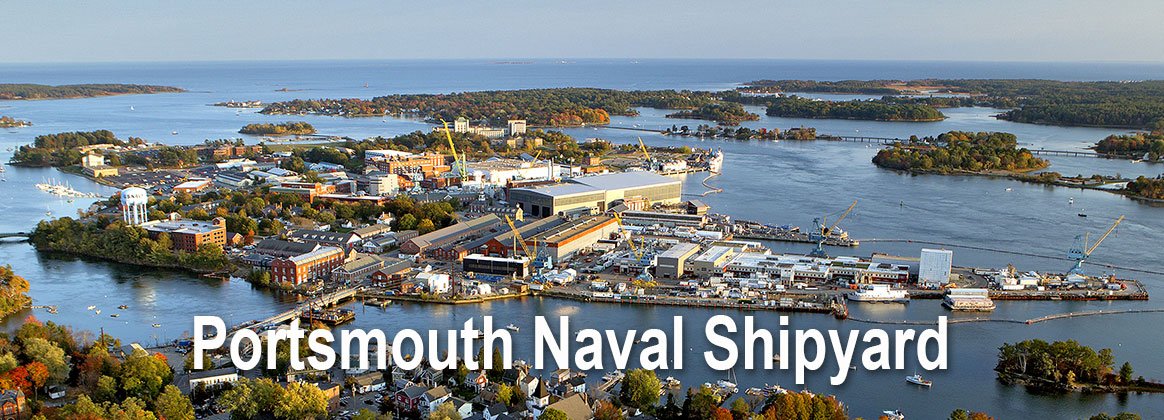Visible from across the Piscataqua River from Portsmouth, New Hampshire, is an impressive structure known as the “Building Ways” (Building 178), with its iconic blue marquee proudly displaying: “Portsmouth Naval Shipyard, Estab. 1800” and the motto: “Proud of our past. Ready for our future.” This building’s recognizable outline on the shipyard’s waterfront has undergone significant upgrades in the last decade to improve its energy efficiency, renew the exterior, and create a modernized material handling facility. Now, a new project is underway to optimize available space within the existing footprint and improve submarine depot maintenance efficiency, bringing the historic structure into the 21st Century. With funding through the Navy’s Shipyard Infrastructure Optimization Program (SIOP), the Building Ways will soon transform into the “Virginia-Class Waterfront Production Facility.”
SIOP is a holistic plan that integrates all infrastructure and industrial plant equipment investments at the Navy’s four public shipyards to meet nuclear fleet maintenance requirements, as well as improve Navy maintenance capabilities by expanding shipyard capacity and optimizing shipyard configuration. SIOP projects are essential to the on-time completion of submarine availabilities and critical to maintaining the U.S. Navy’s maritime superiority.
The SIOP projects being planned and executed at all four shipyards are a part of the Navy’s once-in-a-century investment and are the responsibility of Commander, Naval Facilities Engineering Systems Command (NAVFAC), Rear Adm. Dean VanderLey, and the Program Executive Officer Industrial Infrastructure (PEO II), Mark Edelson, Senior Executive Service. The projects are overseen locally by Officer in Charge of Construction, Portsmouth Naval Shipyard (OICC PNSY) Capt. Frank Carroll, Russ Gagner, PNSY SIOP program manager, with cooperation from the Public Works Department, led by Cmdr. Liz Durika, public works officer.
At Portsmouth, the shipyard has been redefining its processes and consolidating efforts for over a decade. During this process, Building 178 was identified as having 92,000 sq. ft. of space available above the existing main floor due to its 84′ clearance height, once necessary to construct ships and submarines.
“During World War II, the Navy transformed Bldg. 178 from a wooden submarine construction facility to a steel, state-of-the-art facility capable of building and launching three submarines at once into the Piscataqua River,” said Gagner. “We will use that same World War II exterior shell to enclose a four-story waterfront facility and provide our project teams an optimized work environment.”
Submarine Overhaul Project Teams will be located in the new building and be comprised of operations staff, engineering personnel, production field shops, and fleet forces. The shops will be on the first level, with a supervisory mezzanine on the second level and project team functions on the third and fourth levels. The facility will support the Fleet’s need for more effective and efficient submarine overhauls.
“The project, while a huge win for the shipyard’s future, hasn’t been without challenges,” said Carroll. “For example, erecting most of the steel frame at night was necessary so construction did not interfere with time-critical training occurring adjacent to the site. The partnership between PNSY, Commander, Navy Installations Command, OICC PNSY, Whiting-Turner, and Colby Engineering epitomized the meaning of teamwork.”
“SIOP projects are essential to the on-time completion of submarine availabilities and critical to maintaining the U.S. Navy’s maritime superiority in this current strategic competition environment,” said VanderLey. “Critical to that effort is the team who is making it happen. I am proud of the sense of purpose and commitment our team is displaying on projects at each of our four public shipyards. The future is built on their example.”
The historical importance of the Building Ways project to the country and the Navy is undeniable. The original construction began in 1939 to replace the existing, partially enclosed wooden shipways built in 1917. During World War II, the Navy expanded the new structure twice to meet the Fleet’s needs.
On January 24, 1944, in a single day, the shipyard launched four submarines constructed at the yard–a remarkable achievement. One of those subs, the USS Scabbardfish (SS-397), was launched from the Building Ways. By the end of WWII, PNSY had constructed and successfully launched more than 77 submarines—nearly one-half of the U.S. submarine force at that time.
In the years that followed, the shipyard became known as a hub for submarine innovation. The first tear-drop-shaped submarine, USS Albacore, was launched from the Building Ways in 1953. The structure was expanded again from 1960-1961, as Portsmouth continued to be the primary facility for submarine construction throughout the Cold War. On November 11, 1969, the 134th and last submarine built at the shipyard, USS Sand Lance (SSN 660), was launched from the Building Ways. This iconic structure would go quiet for many years, serving primarily as a space to store equipment, parts, and supplies.
As four decades passed, the Building Ways began to fall into a state of disrepair, and its infrastructure had lost value as a waterfront resource. However, in 2012, the shipyard decided to right the ship. Due to its central location near the dry docks, and a dire need for more usable space, they sought funding to repair the building’s envelope, structure, utilities, and cranes. Funding for the project was made possible through the Navy’s Restoration Modernization Energy Program (RMeP), designed to repair facilities with an eye toward energy savings and sustainability.
“As a result of RMeP, the Building Ways has a façade designed for energy efficiency along with rooftop solar panels to generate a portion of the facility’s power needs,” said Durika. “Thanks to this project, new life was breathed into the building, making the current project possible.”
Today, the shipyard is the center of excellence for the maintenance, repair, and modernization of the U.S. nuclear fast attack submarine fleet. The new Virginia-Class Waterfront Production Facility is scheduled for completion in the fall of 2024.

